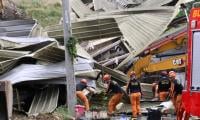Walk to Karbala
It was just after 2:00am when we left one of the many roadside rest and recuperation camps – this run by a generous Pakistani family – along the road from Najaf to Karbala in Iraq.
Amid the rapidly growing numbers of people travelling on foot for the observance of the ‘chehlum’ or ‘Arbaeen’ of Imam Hussain (a.s), such camps have become central to supporting pilgrims in the face of likely physical fatigue.
Once we resumed our walk, the effect of the almost full moonlit night was vividly amplified with the lineup of well-lit stalls for food, tea and water on one side of the road. Just across the road on the other side, mattresses were laid out on the floors of the mostly air-conditioned sleeping halls, for those seeking a break in their spiritually elevating journey.
Meanwhile, well-stocked medical camps along side facilities like cobblers’ stations, foot massage points and temporary tailoring shops were placed every few kilometres along the route in case their services were needed. In brief, nothing appeared to have been left to chance.
In the buildup to the 40th day following the martyrdom of Imam Hussain (a.s) and his companions on 10th Muharram, Iraq has witnessed a rapid surge of pilgrims travelling on foot from Najaf to Karbala.
Like previous years, this year’s journey came almost 1400 years after Imam Hussain (a.s) was massacred along with his companions in Karbala, while the women and children left behind were captured, tortured and imprisoned in extremely inhuman conditions.
The tragedy of Karbala has been remembered year after year, as Muslim mourners have joined hands through events ranging from majalis (gatherings where events from Karbala are remembered) to public processions especially on key dates. In South Asia, traditions like the recitation of the ‘Marsiya’ (poetry built upon verses of mourning of events of Karbala) in Urdu owe their birth and progress to the tragic history of Karbala.
In this background, the ‘walk’, known as ‘mishi’ has fast become popular especially since Iraq’s former dictator Saddam Hussain was thrown out of power.
In recent years, this land of ancient civilisations has witnessed a sharp increase in donors and volunteers arriving from across the world at this time of the year. They are bound together with just one purpose – to serve the pilgrims heading to Karbala.
The vibrant history of Iraq touches pilgrims with full intensity as they depart from the shrine of Hazrat Ali (a.s) in Najaf and walk through the ‘wadi us salaam’ cemetery – likely, the oldest grave yard across the Muslim world.
Iraqi observers this year put out their ballpark estimates of anywhere between 30 million and 40 million participants in the Najaf to Karbala walk. The pilgrims represented multiple linguistic, ethnic and national backgrounds, coming from Iran and the Arab world to south and Central Asia, Australia, the rest of Asia, Africa and the western world.
The pilgrims ranged from able bodied young men and women to children. At times wheelchair or otherwise dependent individuals, determined to beat the odds, have all joined in.
The walk signifies not only an ever-increasing public participation in what many consider a vital duty, it also underlines the transition of Iraq to a more participatory system of government. It’s hardly surprising that despite multiple daily life challenges, especially surrounding the poorest of the poor, a sense of emancipation has swept across Iraq.
Iraq’s distinctly rich history has helped reinforce the image of a long journey undertaken, all in the service of the shrines of Karbala. Among the prized items put on public display, a room with precious artefacts located near the final resting place of Hazrat Abbas (a.s) stands out among the many glaring examples
It is here that, among the swords of successive chieftains presented as gifts, lies a sword belonging to Nadir Shah, the powerful 18th century Persian king. Legend says that he presented his sword in the name of Imam Hussain during a visit to the shrine. Among the relatively more recent but telling artefacts, parts of the gold laden dome from the shrine of Hazrat Abbas (a.s) is also kept on display.
Meanwhile, visitors to the shrines and their surrounding areas find themselves graphically reliving accounts of events from Karbala on the day of the massacre. These range from locations of tents belonging to the followers of Imam Hussain (a.s) to a literal mapping of where different martyrs succumbed to attacks and fatal injuries.
Going forward, the legacy of Arbaeen will undoubtedly continue to work in the foreseeable future as a magnet for visitors to Iraq. It’s a powerful reality embedded in well-documented history.
More importantly, the way generations of Muslims from across the world have chosen to remember this very powerful incident has only preserved the legacy of Karbala for the future.
The Najaf to Karbala walk fundamentally is not just about testing the limits to physical endurance. The event also underlines the way in which Muslims are able to unite in paying homage to Imam Hussain (a.s) and his followers for all times to come.
The writer is an Islamabad-based journalist who writes on political and economic affairs.
Email: farhanbokhari@gmail.com
-
 Canadian PM Visits China After A Decade Of Diplomatic Strain: What Deals Are In Focus?
Canadian PM Visits China After A Decade Of Diplomatic Strain: What Deals Are In Focus? -
 New York Plans Limited Rollout Of Self-driving Taxis
New York Plans Limited Rollout Of Self-driving Taxis -
 Sarah Ferguson Faces Painful Choice Between Peace, Family Bond
Sarah Ferguson Faces Painful Choice Between Peace, Family Bond -
 Nvidia Clarifies ‘no Upfront Payment Needed For H200 Chips Production’
Nvidia Clarifies ‘no Upfront Payment Needed For H200 Chips Production’ -
 Africa First: Nigeria Set To Approve Landmark AI Rules For Digital Economy
Africa First: Nigeria Set To Approve Landmark AI Rules For Digital Economy -
 WhatsApp Tests Built-in Supervision Feature Long Missing From The App
WhatsApp Tests Built-in Supervision Feature Long Missing From The App -
 Iceberg A-23A Turns Blue As Scientists Warn Collapse Is Imminent
Iceberg A-23A Turns Blue As Scientists Warn Collapse Is Imminent -
 FIFA Selects Stats Perform For Betting Data And Live Streaming
FIFA Selects Stats Perform For Betting Data And Live Streaming -
 Is Jessica Simpson Really Joining 'The Bachelorette'?
Is Jessica Simpson Really Joining 'The Bachelorette'? -
 Brayden Point Injury Raises Concern After Early Exit For Tampa Bay Lightning
Brayden Point Injury Raises Concern After Early Exit For Tampa Bay Lightning -
 Meghan Trainor Addresses 'toxic Mom Group' Rumours Again
Meghan Trainor Addresses 'toxic Mom Group' Rumours Again -
 Mattel Autistic Barbie Doll Aims To Boost Representation And Inclusion
Mattel Autistic Barbie Doll Aims To Boost Representation And Inclusion -
 William Makes Calculated Move To Future-proof His Public Role Amid Harry Return
William Makes Calculated Move To Future-proof His Public Role Amid Harry Return -
 Elijah Wood Breaks Silence On Possible Return To New 'Lord Of The Rings' Film
Elijah Wood Breaks Silence On Possible Return To New 'Lord Of The Rings' Film -
 Aaron Rodgers Wife: What The NFL Quarterback Has Said About His Marriage
Aaron Rodgers Wife: What The NFL Quarterback Has Said About His Marriage -
 Buckingham Palace Shuts Down Claims It Can Step In On Harry’s Security
Buckingham Palace Shuts Down Claims It Can Step In On Harry’s Security



